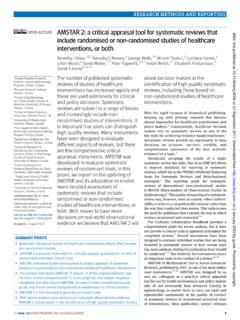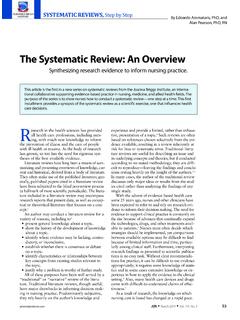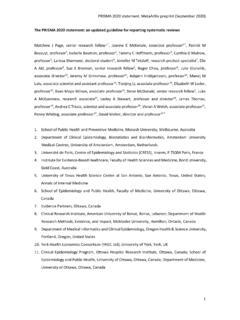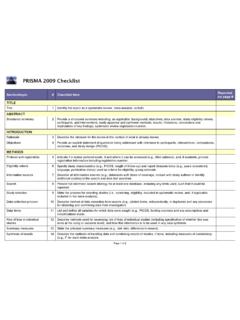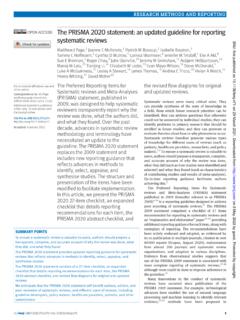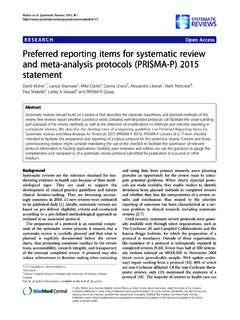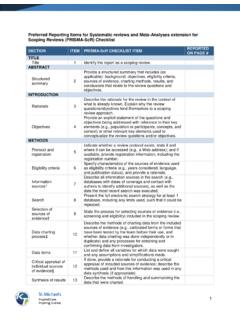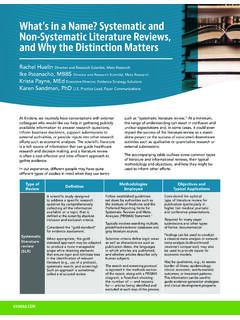Transcription of Guidelines for Systematic Reviews
1 1 Guidelines for Systematic Reviews Revised November 2017 The American Journal of Occupational Therapy (AJOT) uses the Preferred Reporting Items for Systematic Reviews and Meta-Analyses (PRISMA) Guidelines as a basis for Systematic Reviews . Please refer to for details on the PRISMA Guidelines . The PRISMA checklist is available at This document describes requirements for Systematic Reviews to be published in AJOT. Direct questions about these requirements to the appropriate AOTA staff: review content: Lorie Richards, AJOT Editor-in-Chief, Production: Caroline Polk, TITLE Provide a descriptive title for the Systematic review .
2 Identify the report as a Systematic review , meta-analysis, or both. (PRISMA Item #1) ABSTRACT/STRUCTURED SUMMARY Provide a structured summary including, as applicable, background; objectives; data sources; study eligibility criteria, participants, and interventions; study appraisal and synthesis methods; results; limitations; conclusions and implications of key findings; and Systematic review registration number (if included). (PRISMA Item #2) INTRODUCTION Rationale Describe the rationale for the review in the context of what is already known. (PRISMA Item #3) Statement of Problem (formulation of the topic for the Systematic review ) What is the problem addressed by the focused question/topic?
3 What significance does addressing this problem have for the following items (address areas as appropriate): The clinical and community-based practice of OT The education and training of OT students Refinement, revision, or advancement of knowledge, theory, or research Program development Societal needs Health care delivery and health policy Coverage of payment for occupational therapy services at local, state, and national levels. Background Literature Keeping in mind the expectations and standards of a peer-reviewed scholarly journal, critically synthesize the background information and literature for the problem addressed.
4 2 What is currently known about the problem, and what is not yet known? Provide relevant definitions and descriptions of the intervention and approach, as needed. Discuss how this Systematic review will contribute to our understanding or resolution of the problem addressed. Objectives of the Systematic review Provide an explicit statement of questions being addressed with reference to participants, interventions, comparisons, outcomes, and study design (PICOS), as appropriate. (PRISMA Item #4) If the focused question is part of a group of Systematic Reviews on a topic, state the importance of the focused question relative to the overall topic.
5 METHOD FOR CONDUCTING THE Systematic review In this section, describe the following: Whether a Systematic review protocol exists and if and where it can be accessed ( , URL of website). If available, provide registration information, including registration number. (PRISMA Item #5) Search strategy, including inclusion and exclusion criteria and screening procedures List who conducted the search ( , independent librarian, librarian associated with author s institution). Specify study characteristics ( , PICOS, length of follow-up) and report characteristics ( , years considered, language, publication status) used as criteria for eligibility, giving rationale.
6 (PRISMA Item #6) Present full electronic search strategy for at least one database, including any limits used, such that it could be repeated. (PRISMA Item #8) Procedures for identification and collection of articles List databases and other information sources used to identify relevant studies ( , hand-searching reference lists and tables of contents, contacting content experts). Include dates of coverage of the search. (PRISMA Item #7) State the process for selecting studies ( , screening, eligibility, criteria for inclusion in Systematic review and, if applicable, criteria for inclusion in the meta-analysis). (PRISMA Item #9) Describe method of data extraction from reports ( , piloted forms, independently, in duplicate) and any processes for obtaining and confirming data from investigators.
7 (PRISMA Item #10) List and define all variables for which data were sought ( , PICOS, funding sources) and any assumptions and simplifications made. (PRISMA Item #11) Describe method for assessing risk of bias of individual studies (including specification of whether this was done at the study or outcome level) and how this information is to be used in any data synthesis ( , strength of evidence assessments). (PRISMA Item #12) State the principal summary measures ( , risk ratio, difference in means). (PRISMA Item #13). Describe the method of handling data and combining results of studies, if done, including measures of consistency ( , I2) for each meta-analysis.
8 (PRISMA Item #14) 3 Specify any assessment of risk of bias that may affect the cumulative evidence ( , publication bias, selective reporting within studies). (PRISMA Item #15) Describe methods of additional analyses ( , sensitivity or subgroup analyses, meta- regression), if done, indicating which were pre-specified.* (PRISMA Item #16) RESULTS Give numbers of studies screened, assessed for eligibility, and included in the review , with reasons for exclusions at each stage. Provide a flow diagram using the format shown in the Flow Diagram on p. 9. (PRISMA Item #17) For each study, present characteristics for which data were extracted ( , study size, PICOS, follow-up period) and provide the citations.
9 (PRISMA Item #18) Present data on risk of bias of each study and, if available, any outcome level assessment (see item in Method section corresponding to PRISMA Item #12). (PRISMA Item #19) For all outcomes considered (benefits or harms), present for each study (1) simple summary data for each intervention group and (2) effect estimates and confidence intervals, using a forest plot as appropriate. (PRISMA Item #20) Present the main results of the review . If meta-analyses are done, include for each, confidence intervals and measures of consistency. (PRISMA Item #21) Present results of any assessment of risk of bias across studies (see PRISMA Item #15).
10 (PRISMA Item #22). Provide a table summarizing the risk of bias using the format shown in Table Template 1 on p. 7). Give results of additional analyses, if done ( , sensitivity or subgroup analyses, meta- regression [see item * in Method section corresponding to PRISMA Item #16). (PRISMA Item #23) To synthesize the articles and create the results, do the following: Organize studies according to themes. Organize and group studies within the themes, rather than report on results of individual studies. Synthesize by answering the question, What do we know, from an evidence-based perspective, about specific dimensions of the focused question?]
